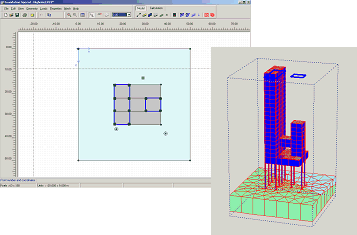infos:
GRAPHICAL INPUT OF PROJECTS
A project geometry is modelled using a top view approach. The input of soil data, structures, construction stages, loads and boundary conditions is based on convenient CAD drawing procedures, which allows for a detailed and accurate modelling of the major geometry. From this geometry a 3D finite element mesh is generated.
BORE HOLES
Soil layers are defined by means of bore holes. Multiple bore holes can be placed in the geometry to define a non-horizontal soil stratigraphy or an inclined ground surface. Plaxis automatically interpolates layer and ground surface positions in between the bore holes.
WORK PLANES
Structures are defined in horizontal work planes. Multiple work planes can be defined to create complex foundations, multi-storey basements and relevant parts of the upper structure.
AUTOMATIC MESH GENERATION
The Plaxis 3D Foundation program allows for an automatic generation of unstructured 2D finite element meshes based on the top view. The 2D Mesh generator is a special version of the Triangle generator. There are options for global and local mesh refinement. From this 2D mesh, a 3D mesh is automatically generated, taking into account the soil stratigraphy and structure levels as defined in the bore holes and work planes.
VOLUME ELEMENTS
Quadratic 15-node wedge elements are available to model the deformations and stresses in the soil. Due to non-horizontal soil stratigraphy, these elements may degenerate once to 13-node volume elements or twice to 10-node tetrahedral elements.
BEAMS
Foundations may involve structural objects like walls, floors and beams. A special type of beam element can be used to model slender one-dimensional objects with a significant flexural rigidity. The stiffness of these elements is defined using elastic stiffness properties or non-linear elastic deformation curves.
WALLS AND FLOORS
Special plate elements can be used to model raft foundations, basements, walls and floors of buildings, as well as other parts of structures. The behaviour of these elements is defined using elastic stiffness properties or non-linear elastic deformation curves (M-ê and N-å diagrams).
INTERFACES
These joint elements are automatically added to walls to allow for a proper modelling of soil-structure interaction. Interfaces may be used to simulate, for example, the thin zone of intensely shearing material at the contact between a wall and the surrounding soil. Values of interface friction angle and adhesion that are not necessarily the same as the friction angle and cohesion of the surrounding soil and may be assigned seperately to these elements.
PILES
Circular and square piles can be defined using a pile designer. Solid piles are composed of volume elements whereas hollow piles are composed of wall elements. Pile-soil interaction can be modelled using interfaces around the pile.
LOADS
Plaxis 3D Foundation allows for various types of loads (point loads, line loads, distributed loads) that could be applied in the model. Different loads and load levels can be activated independently in each construction stage. Soil Behaviour:
Soil behaviour back to top
MOHR-COULOMB MODEL
This robust and simple non-linear model is based on soil parameters that are known in most practical situations. Not all non-linear features of soil behaviour are included in this model, however. The Mohr-Coulomb model may be used to compute realistic bearing capacities and collapse loads of footings, as well as other applications in which the failure behaviour of the soil plays a dominant role.
HARDENING SOIL MODEL
As a general second-order model, an elastoplastic type of hyperbolic model is available, which is called the Hardening Soil model. This model allows for plastic compaction (cap hardening) as well as plastic shearing due to deviatoric loading (friction hardening). In comparison with the Mohr-Coulomb model the unloading behaviour of the soil is better taken into account. The Hardening Soil model may be used to calculate realistic pressures below basements and raft foundations and behind soil retaining structures. More detailed information on this model can be found in the Material Models Manual.
STRUCTURAL BEHAVIOUR
Structural behaviour may be defined as linear elastic material orthotropy or as non-linear elastic force-deformation curves. This applies to beams, walls, floors and springs. Geometric orthotrophy of plates with a particular profile can also be emulated to a certain extent.
STEADY-STATE PORE PRESSURE
Complex pore pressure distributions may be generated on the basis of the input of water levels or pore pressure distributions in the bore holes. Plaxis 3D Foundation is a finite element package intended for the three-dimensional deformation analysis of foundation structures. Foundations form the interaction between an upper structure and the soil. Settlements depend on local soil conditions and on the construction method. Especially for pile-raft foundations there is an important interplay between the pile, the raft and the soil to support the forces from the upper structure. In this interplay deformations are a key factor. Such a situation can only be analysed effectively by means of three-dimensional finite element calculations in which proper models are incorporated to simulate soil behaviour and soil-structure interaction. The Plaxis 3D Foundation program offers these facilities. A brief summary of the most important features is presented below.
EXCESS PORE PRESSURE
Plaxis distinguishes between drained and undrained soils to model permeable sands as well as almost impermeable clays. Excess pore pressures are computed when undrained soil layers are subjected to loading. Calculation Features:
links:
http://rapidshare.com/files/21916547/Pl3dfo.part1.rar http://rapidshare.com/files/21917098/Pl3dfo.part2.rar
rarpassword:freeforall
PDF'S TUTORIALS:
http://www.plaxis.nl/upload/productmanuals/3DFV15-Tutorial.pdf http://www.plaxis.nl/upload/productmanuals/3DFV15-GenInfo.pdf http://www.plaxis.nl/upload/productmanuals/3DFV15-Material.pdf http://www.plaxis.nl/upload/productmanuals/3DFV15-Reference.pdf http://www.plaxis.nl/upload/productmanuals/3DFV15-Scientific.pdf http://www.plaxis.nl/upload/productmanuals/3DFV15-Validation.pdf
VIDEOS TUTORIALS:
http://www.plaxis.nl/upload/productvideos/3DF%20-%20Excavation.avi http://www.plaxis.nl/upload/productvideos/3df_bridge.avi http://www.plaxis.nl/upload/productvideos/quay%20wall.avi



